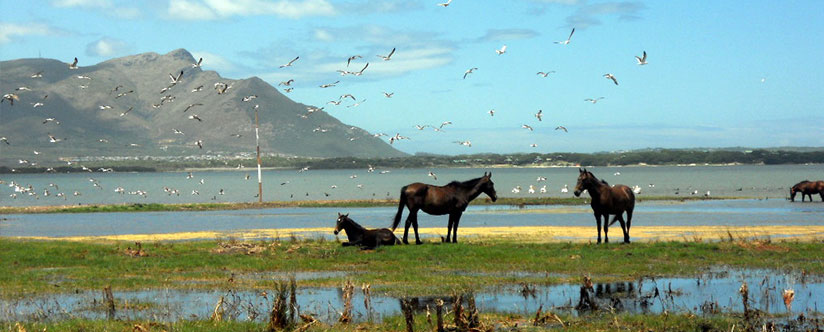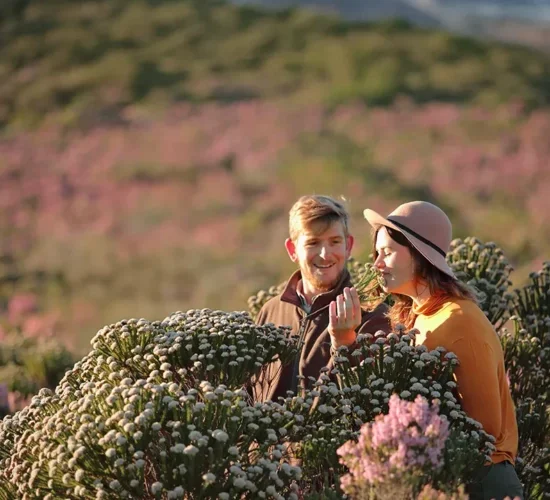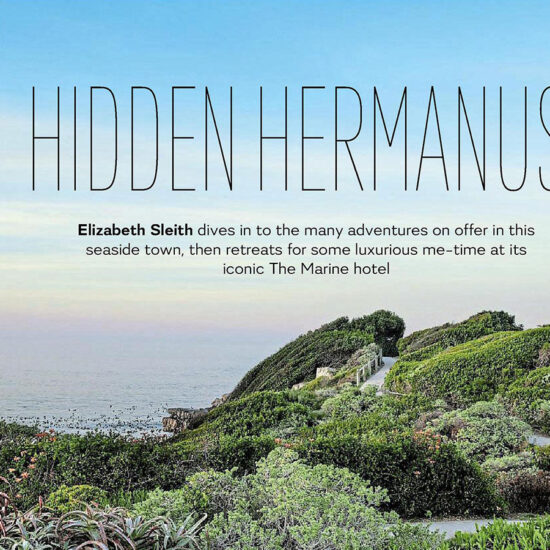Wild Horses

Most of us are aware of and some of the readers may even be participants in the world wide pastime of bird watching – I am referring to birds of the feathered kind, of course! It is a fascinating, low-cost pursuit enjoyed by people of all ages and all walks of life. It brings people close to Nature and gives them a never ending sense of and sensibility for our colourful environment.
Few of us, if any, have ever heard of horse watching. It is not a regular or recognized pastime. Be that as it may, I can assure you that my family and I have, over the past 30 years, enjoyed the most wonderful combination of bird watching and horse watching in the wetland stretching from Botriver lagoon down to Kleinmond. There are 120-odd bird species in the vlei and its surroundings. As a family we became aware of the small group of wild horses in the vlei in 1970 when our eldest son, who was 12 at the time and already a seasoned bird watcher and amateur ornithologist, took us along on his wanderings in pursuit of his birds.
Over a period of thirty years we periodically observed the small group of free roaming horses year after year during our December holidays and saw them slowly increase in numbers. Interestingly enough in those years the majority of foals born were males, which tended to keep down the rate of population increase. In the present group of 19 there are 11 males and 8 females. Of course when these males came to maturity there are fierce fights for supremacy which carries with it the honour and privilege, once a year, of mating with the few available females. As can be expected in such a small group, a high degree of inbreeding took place. However, despite the severe narrowing of the genetic basis, the young stock remains remarkably sound.
The foal in the photograph, born in February 2006 is, yes you have guessed correctly, another male.
The obvious questions are: Where do the horses fit in and what future do they have?
- Ecologically the horses fit into the vlei like hands in gloves. Although much of the vlei is in private ownership, it is in effect treated as a nature reserve. Most nature reserves in South Africa carry a complement of large mammals. Horses are large mammals of the herbivorous kind like zebra, hippopotamus, rhinoceros, etc. They make excellent use of the abundance of grazing in the vlei and are virtually always in excellent condition. They tread footpaths through the ever more dense reed beds thus opening up the necessary channels for drainage.
- Politically they have no competition from other large mammals because there are none in the vlei.
- Economically they threaten nobody’s grazing rights because there are no claims on the grazing rights.
- Over decades this group of horses and their ancestors have adapted themselves remarkably well to their marshy habitat. Like horses everywhere they grow thick winter coats which give adequate protection against the cold winter winds. In the middle of winter and well into Spring when the water levels are high before the outlet at Kleinmond opens up or is breached, they are forced out to the fringes of the vlei, but in all the years I have never observed them out in the open veld which run from the edge of the vlei to the fence next to the tarred road. They do of course venture out into the dunes between vlei and ocean but not often. They absolutely prefer the flat marshy area in the centre. It may be that they feel safer there.
- Other obvious adaptations are e.g. the big, saucer shaped hooves which is an adaptation to the soft, spongy surface. However, the hooves are most definitely not webbed, as one journalist had it. What is also remarkable is the soundness of the hooves and the limbs. On soft, sandy terrain, in other parts of the country horses’ hooves sometimes grow out too long and become grotesquely malformed. This is certainly not the case with these horses. Their hooves are perfectly shaped and apparently of sound texture, despite the soft and constantly wet underfoot conditions.
- They have interesting grazing habits and their choice of diet must be excellent for them to remain in such good physical condition. They are often seen grazing in the shallow water, pushing the muzzle down under the surface to pull up and ingest mouthsful of water grass. But they also of course take the kweek and buffelsgras and even some of the edible shrubs as well as lots of fluitjiesriet on the sides and in the reed beds.
- In social behaviour they conform to what is known about free roaming horses. The three mature and two juvenile stallions exactly know their respective places in the pecking order. One of the older stallions has for years been the constant companion of one of the older mares, which has never had a foal. So one of these two must be infertile. When a mare is on heat the younger stallions will challenge and if it is the first heat after foaling, the young foal is in danger of being kicked or trampled.
- The future of the horses depends on many factors. For the past 40-odd years the small group had no enemies and, fortunately for themselves and the owners of the vlei, their numbers remained small. They exerted no pressure on the environment to which they are ideally adapted. This happy situation may very well last for another 40 years if the numbers, in my estimation, do not go beyond thirty-odd animals.
- The horses are not wild in the true sense of the word. Although the present group and their ancestors for the past 40 years never had a halter over their heads and will react like any, in this case big and strong, wild animal when cornered or captured, they have recently become quite used to our presence when we visit them in the vlei and also I believe to the presence of riders from Botriver and Arabella who on occasion approach them on horseback.
- They have become well-known and their existence has given rise to a number of fanciful theories and romantic tales about their origins. One of these is that they are descended from horses hidden from the British when horses were commandeered for the army in the Anglo Boer War (1899 – 1902). According to another story they swam ashore when the troopship Birkenhead sank near the coast. I believe that I have the true, but rather prosaic, story about their beginnings from the late mr Jack Delport who was the son of the Caledon farmer who owned the entire stretch of land from the present farm Ysterklip( now the Arabella golf estate) to Kleinmond.
- The distant forebears of our “wild horses” were farm horses, used for ploughing and hoeing and pulling wagons and carts and even riding before most of these activities became fully mechanised in the years following World War II. But, however prosaic their descent may be, for me and other students of horse breeds and types they are very special. They may be the very last representatives of what Schreuder (1915) called the Bolandse Waperd, a distinct and, in its hey days very useful offshoot of the famous Cape Horse of the 18th and 19th centuries which have, since the devastation of the Anglo Boer War been obliterated through injudicious crossbreeding. The exterior conformation of the vlei horses shows this relationship quite clearly and the more inbred they became the more obvious and fixed their resemblance to their true forebears showed up in the body conformation.
In the publication Horses of the Anglo Boer War, I pointed out that when, in October 1899, the burghers of the republics of Transvaal and Orange Free State went to war against the mighty Imperial war machine, they joined their commandos on their homebred South African horses. All of these were descendants of the famous Cape Horse of the 18th and 19th centuries. Their forebears carried first the hunters and explorers and later the Voortrekkers to the north. Some of them found a foothold in the mountain kingdom of Lesotho where the even more well-known Basuto Pony developed as a local strain, very well adapted to rocky, mountainous terrain and of a wonderful disposition and powers of endurance.
Before the war started and well into the siege phases, the British commanders and most of their horse experts, though not all, looked down upon the locally bred Boer horses and Basuto Ponies as too small and entirely unsuitable for the needs of the cavalry and artillery. However, as the war went into the guerilla phases and dragged on for almost three long years, more and more responsible British officers came to appreciate and, indeed, covet the local product. Major A.H. Lane in his Horses for War Purposes said: This was the fatal mistake we made in South Africa in 1899. Thousands of hard little horses could have been procured locally. But these were allowed to be taken by the enemy and we imported a comparatively useless animal at about double the cost. Had the War Office listened to proper advice in 1898-99, our columns during the first part of the war could have been well mounted on local horses. But the enemy got these and we tried to get near them with men mounted on soft, unseasoned animals.
The burghers on their horses made some incredibly long rides over the length and breadth of the country, harrying the enemy and refusing to surrender to numerically far superior forces. The epic ride of General Smuts’ commando from their crossing of the Orange River near Zastron to Springbok in the North Western Cape, is a classic example. This was a journey of at least 2000 kilometres frought with danger and hardship for men and horses. On numerous occasions General Christian de Wet and his commando miraculously escaped the British clutches on horseback. One of these escapes over the Magaliesberg between Pretoria and Rustenburg sounds unbelievable if one crosses over that same route on foot today. It could only have been done on the most surefooted and most trustworthy of horses. This is exactly what the Boer horses and Basuto ponies were and their descendants still are.
Copyright: F J van der Merwe, P O Box 664, Kleinmond 7195 (Used by kind permission)
photo credit to Karin Holtzhausen (https://findingprettyagain.blogspot.co.za)
- IncludedWild Horses
- Not IncludedNatureRelaxationHobbyEnthusiastsFamily-fun




